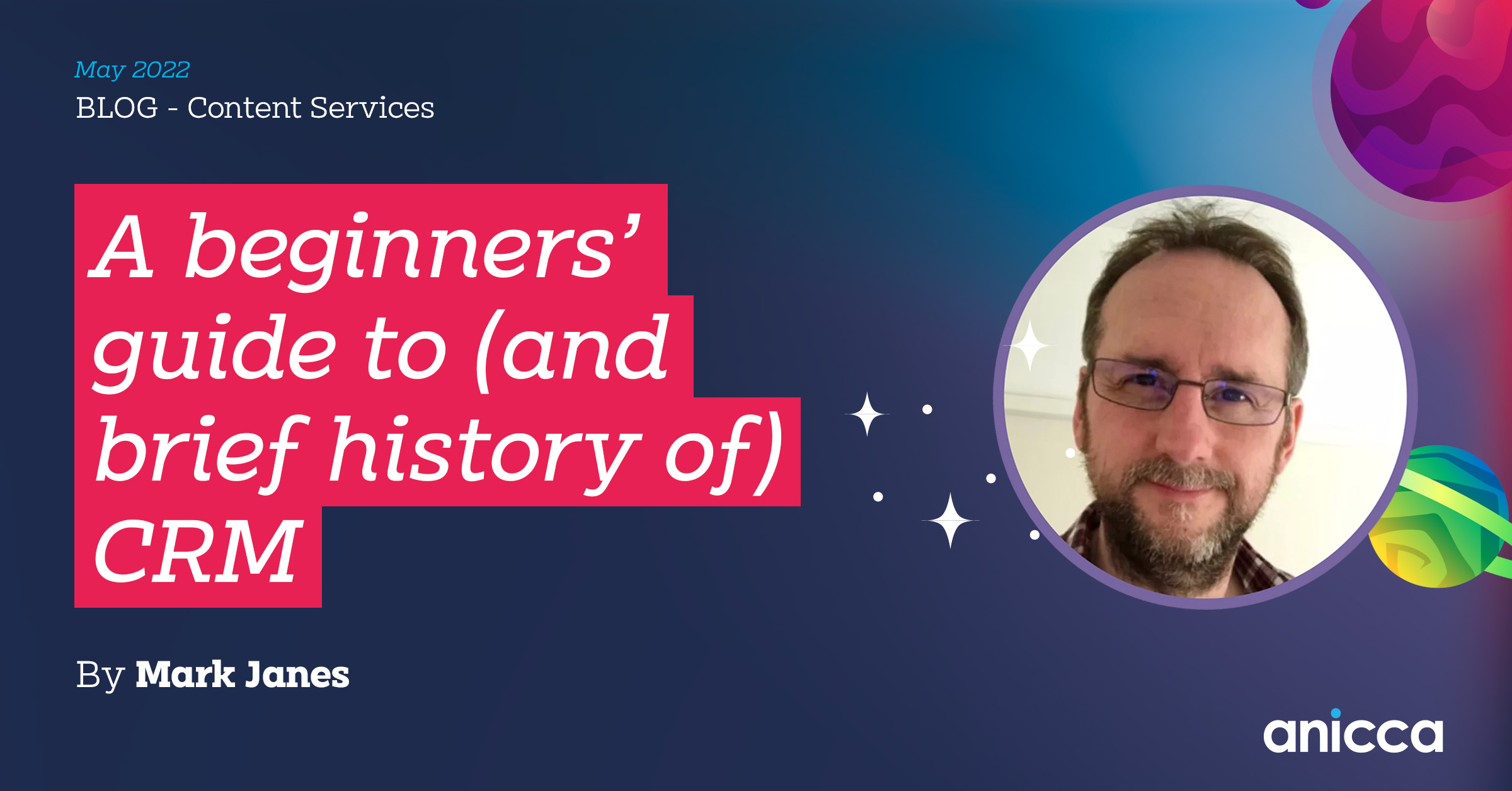A beginners’ guide to (and brief history of) CRM

CRM (Customer Relationship Management) is not a new concept. Indeed, it’s been an essential part of human nature since the very first days of trading; all that has changed is the recognition of it as a business discipline and the methods by which it is carried out.
Meeting on Zoom, taking notes in OneNote and arranging the next call in Google Meets is fundamentally no different from how a salesperson would have operated 100 years ago; all that has changed is the technology used to achieve the outcomes. Whether it be trade of goods, services or ideas, the basics are the same; discussion of opportunity, negotiation of contract, delivery of product. All based on establishing, nurturing and harvesting relationships; it’s in our nature to buy and sell.
As technology has evolved and accelerated, our capacity to analyse and leverage these relationships has exploded. Entire business empires have been built on better understanding of customers, data held about them and its successful application; Amazon and Facebook spring to mind. All of these business and services have been built on the simple premise that technology has allowed us to crunch numbers, perform analysis and spot trends far faster and better than any human (team) could ever do. And the rise of AI has made even the human element in the process more secondary.
That is why you can now take a degree or a masters in all manner of business data analytics subjects. Data is processed into information, information is transformed into knowledge and knowledge becomes power. So, how did we get to this point and how do we exploit that technology to serve our businesses better?
The recent evolution of CRM
CRM, as a business discipline came to the fore in the 1990s as mass computing became affordable for many levels of business and recording of interactions, became much quicker and easier; years before the internet took hold. Goldmine and Maximiser were both early entrants alongside much larger data-oriented organisations such as Oracle and SAP. Call centres’ capabilities boomed with immediate access to a customer’s contact details, order history and full record of interactions. Customer service could become customer care.
Before long, the realisation dawned that there was an exponentially growing mountain of data within many businesses and that there may be knowledge within that data that could provide fresh insights on the best types of customers, where they could be found and how they could best be reached and communicated with. And so, data mining took off.
The next logical step came in building on that insight and starting to make predictions and forecasts based on past performance; what had or hadn’t worked in the past. Understanding how customers had been lost or retained influenced future campaigns and approaches. Forecasting became a real science, especially when blended with external and third-party data that was becoming more readily available and affordable.
It wasn’t long before that enhanced information became the basis for much more targeted and personalised campaigns, through the use of demographics data blended with proprietary customer data; in essence, the early days of personas building. And then digital marketing arrived and functionality expanded at an exponential rate. And it continues to do so with social media providing probably the best examples of the evolution of such campaigns.
However, simply by the nature of that exponential growth, the human element of the processing, as the most costly part of virtually any operation, hit a peak. It simply wasn’t viable to keep adding personnel to work solely on data processing. The competitive advantage became about the speed, accuracy and value of the insight. And so, automation became the watchword. What we now see as standard was once considered groundbreaking. Email campaigns that were based on timings, responses and funneling; chatbots that laid much of the groundwork for today’s AI applications; and workflows that removed both a lot of tedium and margin for error.
Why do we need a CRM system? And what to look for
Based on everything said so far, it might seem naïve to ask ‘Why do we need a CRM system?’ but the answers, like the systems, are numerous and varied.
Your need for a CRM system (or maybe the evolution of an incumbent system) will be based on a range of factors: where your company is in its life cycle, the culture of your organisation, the products/services that you offer and the strategy that you’re following. You obviously don’t want a system that is too simple for your needs, but you should also consider your growth plans and the functionality that you might require in the not-too-distant future.
The marketplace is crammed with different types of CRM systems and approaches, relating to different types of offerings, sizes of organisations, levels of required sophistication and complexity and, of course, budget. Only you will know (and find) a solution that fits your needs, but here are a couple of questions to ask and points to check:
Do we want a system that works (more or less) out of the box, one that we customize or one that is built bespoke for us? On the point of a bespoke system, bear in mind that you could become tied to a single developer for future developments which could be a high-risk option.
What do we need the outputs to be, since these will influence the inputs that we specify. Is the bias more towards information storage, report compilation, automation of processes, contribution to forecasting or all of the above? These are basic questions but that only makes them more important to answer.
Then there are some key points to look for in a system. How easy is it to access remotely and is it available 24/7? The old 9-5 model is long gone so around-the-clock access is now considered essential, especially if you’re operating across time zones.
How do communications with the system work? Are existing hardware set-ups sufficient or are other upgrades needed? Same goes for software. What level of training will be required and for whom?
How will the system integrate with existing software, set-ups and processes? And what will the integration process be for your employees? Who will need to be trained, on what areas and how long will it all take?
What is the extent and nature of support and development that you can expect and require? This will vary according to the source of the system you acquire but make sure to check that it’s fit for your purpose. If the helpdesk is only open 10am-3pm Monday-Friday, you might need to reconsider.
Overall, think about how the system will fit with your organisation. Obvious points might be the number of licences/users or upgrading the spec of hardware. Harder points to quantify would be the amount of upskilling that might be needed, does the approach tally with your company culture and how will it be able to expand as your organisation grows. With competition so fierce to win new customers, there are plenty of free trials out there that can help with your decision-making.
GDPR
The repercussions of the GDPR legislation continue to reverberate around the digital marketing world, with recent and ongoing changes affecting major players such as Apple, Microsoft and Google, so undoubtedly your own business will also be affected. Recent court cases and judgements have demonstrated that the regulations have teeth and those with the power to act do so. To find out more about how GDPR relates to CRM activity, watch the related webinar to this blog, where this and many other avenues are explored.
How much are you changing?
The impact of introducing a CRM system should never be underestimated. At its most fundamental it can represent and effect a culture change, which in turn can bring as much disruption at first as it does benefits in the long run. It is never simply the installation of some new software, nor is it simply a sales tool or a customer database. In fact, it’s unlikely that any part of your organisation won’t be affected by the introduction. That means a whole change management programme will be required; it doesn’t have to be large, but it definitely needs to be thorough.
Where now?
So, where next? Well, cost is probably a key factor in your decision and there are plenty of options available. Take a browse through discovercrm.com for some excellent resources to help with your decision-making.
And what do you want the return on your investment to be? Even a free system will require a lot of time and effort to get right, so it’s vital to be clear on what you want your gains to be, the waste you’re eliminating and the benefits that you’re seeking.
If you’re in the fortunate position to incorporate or import pre-existing data then you should immediately have access to a mine of data that previously might have been difficult or costly to access. New reporting functions might help significantly in providing insights and commercial advantages.
There are numerous approaches to selecting a CRM system but a simple technique is to work through the operation of the system in reverse. Start with the outputs that you will require; reports, forecasts, KPI measurements, day-to-day running etc. And who will use those outputs and how? If you can define these key pieces, you will be off to a great start.
Secondly, consider the data that will be required to create those outputs. If not managed carefully, this can turn into an almost endless task with countless datapoints being requested and an entirely bespoke system being created on paper that can’t be achieved in the real world, so set boundaries as early as possible and stick to them. If the expenditure on the system warrants it, the use of an external systems analyst could help hugely here.
And finally, spend some time looking at where you are at now as an organisation and where you want to land at the conclusion of the implementation. How big is the gap? You should already know if the project is feasible and affordable; what you’ll need to assess is the size and number of individual phases. Milestones and deadlines are critical in successful management, even on a smaller project.
Conclusion
Implementing a CRM or MAS (marketing automation software) system and culture can appear a daunting project, particularly if it’s a leap into the unknown but two things are absolutely certain: the assistance and resources available are plentiful, and the longer you wait to take the leap, the greater the challenge will be. And in case you missed it further up, here’s a great starting point discovercrm.com



